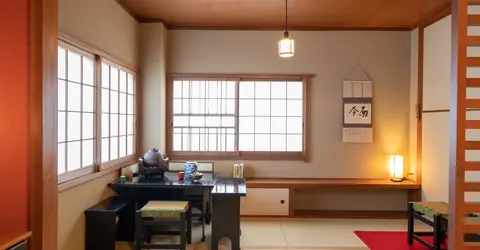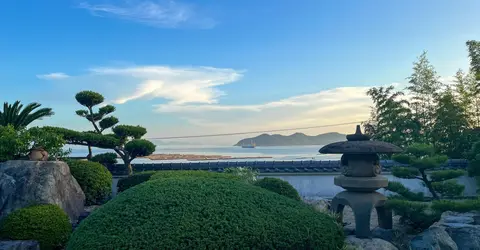Nagi Museum Of Contemporary Art
Nagi Museum Of Contemporary Art (Nagi MOCA) was designed as a collaboration between the architect, Arata Isozaki, and the artists who created the works specifically for the museum. The artists are: Aiko Miyawaki, Kazuo Okazaki, Shusuka Arakawa (1936-2010) and Madeline Gins.
Nagi Museum Of Contemporary Art (Nagi MOCA) 奈義町現代美術館, 岡山
Jake Davies
Away from the big cities, the rural backwaters of Japan are surprisingly well stocked with imposing auditoriums, museums, and other types of cultural facilities that would not look out of place in any major world city.

Nagi Museum of Contemporary Art, Okayama
"Sun" one of the unusual buildings by Arata Isozaki at Nagi MOCA
Most were planned and financed before the so-called bursting of the bubble when Japan was seemingly awash with unlimited funds, and most were designed by internationally renowned architects, both Japanese and foreign, and were very much vanity projects both for the architects and for the local town councils that commissioned them.
However, now many are closed down because the anticipated visitors didn't materialize and also because the maintenance and upkeep of such structures is too great for the dwindling budgets of depopulating rural towns.

"Moon" one of the Arata Isozaki buildings at Nagi MOCA
"Utsurohi" an artwork by Aiko Miyawaki at Nagi MOCA
However, one such establishment that is still going strong and well worth a visit because of its uniqueness, is the Nagi Museum of Contemporary Art. Located in the mountains of northern Okayama Prefecture not far from Tsuyama, Nagi is a very small rural settlement, and quite an unlikely site for a major art museum.
What makes Nagi MOCA unique is that the place was designed as a collaboration between the architect and the artists who created the works specifically for the museum.
Neither the buildings nor the artworks could exist without the other. There are museums that have been designed to house particular pieces of art, and there are artworks that have been produced for specific location and sites, but as far as I can tell Nagi MOCA is unique in that both processes occurred at the same place.
The architect was the world renowned Arata Isozaki who has designed quite a few buildings in Spain as well as other countries including, of course, Japan.

Another section of the artwork Utsurohi, a collaboration between artist Aiko Miyawaki and architect Arata Isozaki
Hisahi by artist Kazuo Okazaki at Nagi MOCA
Exhibits
The artists are Aiko Miyawaki (1929-2014, married to Arata Isozaki), Kazuo Okazaki (born 1930 in Okayama), Shusuka Arakawa (1936-2010) and Madeline Gins (1941-2014). Gins and Arakawa were partners, both artistically and personally, and were also architects and poets as well as artists.
The three artworks are classified as Earth, Moon and Sun, though that is due to the orientation of the buildings and has nothing to do with the artwork themselves.
Earth is the largest structure and artwork and is by Aiko Miyawaki. The title of the piece is "Utsurohi - a moment of movement". Curved steel rods rise out of a bed of smooth river rocks. At first the setting is outside and the rocks are covered in water. Concrete walls surround the space. As you move along the bed of rocks rises out of the water and enters into a long room that, like a cave, is dark at the far end. There are a number of different textures and shapes: the water, rocks and curving steel rods all change with reflection and shadow. It's a work to move through slowly like a Japanese stroll garden. Architecturally it is reminiscent of many of Tadao Ando's museums.
Moon represents the work of Kazuo Okazaki. The building's plan is a single straight line and a shallow arc. The straight line of the building points to the moon at 10pm on the Autumn Equinox.
It is a very narrow but tall space and surprisingly light. The artwork consists of two curved granite benches set against the curved wall with two small sculptures on the facing flat wall. The title of the work is "Hisashi - that which supplements".
Hisashi is the Japanese word for eaves. The sculptures are made by pouring plaster so that it overhangs an edge. When dry it is removed and hung on the wall. A minimal and contemplative piece.
The final work, Sun, is a massive cylinder (aligned north to south) set on a slope. The end of the structure looks very much like the head of a giant taiko drum. The artwork by Arakawa and Gins is simply titled "Heart" and is entered through a small room on the walls on which are snapshots of Nagi residents.
A spiral staircase takes you up into the cylinder. At first, little can be seen as the end of the room is translucent and hence bright, but as you make your way up the slope and look back you see a representation of the famous Zen garden at Ryoanji Temple in Kyoto. The fact that it is curved around the cylinder and that a rotated copy of it is on the opposite side makes it most disorienting. This is probably the most accessible and talked about of the artworks at Nagi MOCA.
In the main building of the museum are several smaller galleries that host temporary exhibitions and also a tea room/cafe. Not easy to get to, Nagi MOCA is worth the effort as it is truly unique.
Nagi MOCA
441 Toyosawa, Nagi-cho
Katsuta-gun, Okayama 708-1323
Tel: 0868 36 5811
Open 9.30am to 5pm. Closed Mondays, or the next day if a Monday is a National Holiday.
Entry is 700 yen for adults, 500 yen for high school students, and 300 yen for children.
Access to Nagi is quite difficult without a hire car. Nagi is about halfway between Tsuyama in Okayama and Chizu in Tottori. Tsuyama Station is on the JR Kishin and JR Tsuyama lines and is about 20km by taxi to the museum. Chizu is on the Chizukyuko Line and the JR Inbi Line and is about 23km to the museum. The Inbi Line runs between Tsuyama and Chizu. The closest station to the museum is JR Nagi, about 17km from the museum. Tsuyama Station is just over an hour by train from Okayama Station and it is another hour from here to JR Nagi Station.

A disorienting representation of the zen garden at Ryoanji in Kyoto by artists Madeline Gins and Shusuka Arakawa
Access - how to get to Okayama
Rail
Okayama Station is served by the Sanyo Shinkansen line to Osaka (45 minutes), Tokyo (4 hours), Kyoto (1 hour 10 minutes), Nagoya and Fukuoka/Hakata (2 hours). The JR Hakubi Line connects Okayama and Yonago on the Japan Sea coast in Tottori Prefecture.
Bus
Okayama Station is a highway bus terminus for buses to various destinations in the Chugoku region. and beyond. There are long-distance buses to Tokyo (Tokyo Station, Shinjuku Bus Station, Hamamatsucho), Kansai International Airport (KIX), Fukuoka, Hiroshima, Kobe, Kochi, Kyoto Station, Osaka, Nagoya Station, Nagasaki (with a change in Fukuoka), Matsue, Matsuyama, Izumo, Tokushima and Yonago.
Local buses also radiate out from Okayama Station.
Ferry
There are ferry and services to Shikoku and islands in the Inland Sea including Shodoshima from Shin-Okayama Port, 10km south of downtown with buses from Tenmaya Bus Center.
















